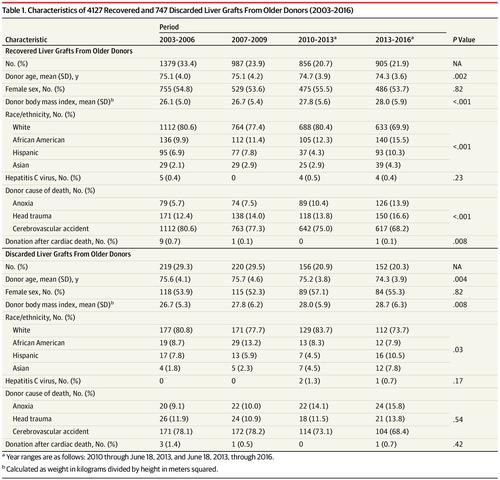当前位置:
X-MOL 学术
›
JAMA Surg.
›
论文详情
Our official English website, www.x-mol.net, welcomes your
feedback! (Note: you will need to create a separate account there.)
Assessment of Trends in Transplantation of Liver Grafts From Older Donors and Outcomes in Recipients of Liver Grafts From Older Donors, 2003-2016.
JAMA Surgery ( IF 15.7 ) Pub Date : 2019-05-01 , DOI: 10.1001/jamasurg.2018.5568 Christine E Haugen 1 , Courtenay M Holscher 1 , Xun Luo 1 , Mary Grace Bowring 1 , Babak J Orandi 2 , Alvin G Thomas 1 , Jacqueline Garonzik-Wang 1 , Allan B Massie 1, 3 , Benjamin Philosophe 1 , Mara McAdams-DeMarco 1, 3 , Dorry L Segev 1, 3, 4
JAMA Surgery ( IF 15.7 ) Pub Date : 2019-05-01 , DOI: 10.1001/jamasurg.2018.5568 Christine E Haugen 1 , Courtenay M Holscher 1 , Xun Luo 1 , Mary Grace Bowring 1 , Babak J Orandi 2 , Alvin G Thomas 1 , Jacqueline Garonzik-Wang 1 , Allan B Massie 1, 3 , Benjamin Philosophe 1 , Mara McAdams-DeMarco 1, 3 , Dorry L Segev 1, 3, 4
Affiliation

|
Importance
In light of the growing population of older adults in the United States, older donors (aged ≥70 years) represent an expansion of the donor pool; however, their organs are underused. Liver grafts from older donors were historically associated with poor outcomes and higher discard rates, but clinical protocols, organ allocation, and the donor pool have changed in the past 15 years.
Objective
To evaluate trends in demographics, discard rates, and outcomes among older liver donors and transplant recipients of livers from older donors in a large national cohort.
Design, Setting, and Participants
Prospective cohort study of 4127 liver grafts from older donors and 3350 liver-only recipients of older donor grafts and 78 990 liver grafts from younger donors (aged 18-69 years) and 64 907 liver-only recipients of younger donor grafts between January 1, 2003, and December 31, 2016, in the United States. The Scientific Registry of Transplant Recipients, which includes data on all transplant recipients in the United States that are submitted by members of the Organ Procurement and Transplantation Network, was used.
Exposures
Year of liver transplant and age of liver donor.
Main Outcomes and Measures
Odds of graft discard and posttransplant outcomes of all-cause graft loss and mortality.
Results
In this study, 4127 liver grafts from older donors were recovered for liver transplant across the study period (2003-2016); 747 liver grafts from older donors were discarded, and 3350 liver grafts from older donors were used for liver-only recipients. After adjusting for donor characteristics other than age and accounting for Organ Procurement Organization-level variation, liver grafts from older donors were more likely to be discarded compared with liver grafts from younger donors in 2003-2006 (adjusted odds ratio [aOR], 1.97; 95% CI, 1.68-2.31), 2007-2009 (aOR, 2.55; 95% CI, 2.17-3.01), 2010-2013 (aOR, 2.04; 95% CI, 1.68-2.46), and 2013-2016 (aOR, 2.37; 95% CI, 1.96-2.86) (P < .001 for all). Transplants of liver grafts from older donors represented a progressively lower proportion of all adult liver transplants, from 6.0% (n = 258 recipients) in 2003 to 3.2% (n = 211 recipients) in 2016 (P = .001). However, outcomes in recipients of grafts from older donors improved over time, with 40% lower graft loss risk (adjusted hazard ratio, 0.60; 95% CI, 0.53-0.68; P < .001) and 41% lower mortality risk (adjusted hazard ratio, 0.59; 95% CI, 0.52-0.68; P < .001) in 2010 through 2016 vs 2003 through 2009; these results were beyond the general temporal improvements in graft loss (interaction P = .03) and mortality risk (interaction P = .04) among recipients of liver grafts from younger donors.
Conclusions and Relevance
These findings show that from 2003 to 2016, liver graft loss and mortality among recipients of liver grafts from older donors improved; however, liver graft discard from older donors remained increased and the number of transplants performed with liver grafts from older donors decreased. Expansion of the donor pool through broader use of liver grafts from older donors might be reasonable.
中文翻译:

2003-2016 年老年捐献者肝移植的趋势评估和老年捐献者肝移植受者的结果。
重要性 鉴于美国老年人口不断增长,老年捐献者(年龄≥70岁)代表着捐献者库的扩大;然而,他们的器官没有得到充分利用。历史上,来自老年捐献者的肝移植与较差的结果和较高的废弃率有关,但临床方案、器官分配和供体库在过去 15 年中发生了变化。目的 评估大型全国队列中老年肝脏捐献者和老年捐献者肝脏移植受者的人口统计、丢弃率和结果趋势。设计、设置和参与者 前瞻性队列研究,涉及 4127 名老年供体肝移植者和 3350 名老年供体移植物的纯肝受者,以及 78 990 名年轻供者(年龄 18-69 岁)的肝移植者和 64 907 名年轻供者的纯肝受者2003年1月1日至2016年12月31日期间在美国进行的供体移植。使用了移植受者科学登记处,其中包括由器官采购和移植网络成员提交的美国所有移植受者的数据。暴露 肝移植年份和肝脏捐献者的年龄。主要结果和措施 移植物丢弃的几率以及移植后全因移植物丢失和死亡率的结果。结果 本研究在研究期间(2003-2016)回收了 4127 例来自老年捐献者的肝移植物用于肝移植; 747 例来自老年捐献者的肝移植物被丢弃,3350 例来自老年捐献者的肝移植物被用于仅肝脏受者。 在调整年龄以外的供体特征并考虑器官采购组织层面的差异后,2003-2006年,与年轻供体的肝移植相比,老年供体的肝移植物更有可能被丢弃(调整后的比值比[aOR],1.97; 95% CI,1.68-2.31)、2007-2009 年(aOR,2.55;95% CI,2.17-3.01)、2010-2013 年(aOR,2.04;95% CI,1.68-2.46)和 2013-2016 年(aOR, 2.37;95% CI,1.96-2.86)(全部 P < .001)。来自老年捐献者的肝移植在所有成人肝移植中所占的比例逐渐降低,从 2003 年的 6.0%(n = 258 名受者)下降到 2016 年的 3.2%(n = 211 名受者)(P = .001)。然而,随着时间的推移,老年捐献者移植物受者的结果有所改善,移植物丢失风险降低了 40%(调整后风险比,0.60;95% CI,0.53-0.68;P < .001),死亡率风险降低了 41%(调整后风险比) 2010 年至 2016 年与 2003 年至 2009 年相比,比率,0.59;95% CI,0.52-0.68;P < .001;这些结果超出了年轻捐赠者肝移植受者中移植物损失(交互作用 P = .03)和死亡风险(交互作用 P = .04)的一般时间改善。结论和相关性 这些研究结果表明,从 2003 年到 2016 年,老年捐献者肝移植受者的肝移植损失和死亡率有所改善;然而,老年捐献者的肝移植丢弃量仍然增加,并且使用老年捐献者的肝移植进行的移植数量有所减少。通过更广泛地使用老年捐献者的肝移植来扩大捐献者库可能是合理的。
更新日期:2019-05-16
中文翻译:

2003-2016 年老年捐献者肝移植的趋势评估和老年捐献者肝移植受者的结果。
重要性 鉴于美国老年人口不断增长,老年捐献者(年龄≥70岁)代表着捐献者库的扩大;然而,他们的器官没有得到充分利用。历史上,来自老年捐献者的肝移植与较差的结果和较高的废弃率有关,但临床方案、器官分配和供体库在过去 15 年中发生了变化。目的 评估大型全国队列中老年肝脏捐献者和老年捐献者肝脏移植受者的人口统计、丢弃率和结果趋势。设计、设置和参与者 前瞻性队列研究,涉及 4127 名老年供体肝移植者和 3350 名老年供体移植物的纯肝受者,以及 78 990 名年轻供者(年龄 18-69 岁)的肝移植者和 64 907 名年轻供者的纯肝受者2003年1月1日至2016年12月31日期间在美国进行的供体移植。使用了移植受者科学登记处,其中包括由器官采购和移植网络成员提交的美国所有移植受者的数据。暴露 肝移植年份和肝脏捐献者的年龄。主要结果和措施 移植物丢弃的几率以及移植后全因移植物丢失和死亡率的结果。结果 本研究在研究期间(2003-2016)回收了 4127 例来自老年捐献者的肝移植物用于肝移植; 747 例来自老年捐献者的肝移植物被丢弃,3350 例来自老年捐献者的肝移植物被用于仅肝脏受者。 在调整年龄以外的供体特征并考虑器官采购组织层面的差异后,2003-2006年,与年轻供体的肝移植相比,老年供体的肝移植物更有可能被丢弃(调整后的比值比[aOR],1.97; 95% CI,1.68-2.31)、2007-2009 年(aOR,2.55;95% CI,2.17-3.01)、2010-2013 年(aOR,2.04;95% CI,1.68-2.46)和 2013-2016 年(aOR, 2.37;95% CI,1.96-2.86)(全部 P < .001)。来自老年捐献者的肝移植在所有成人肝移植中所占的比例逐渐降低,从 2003 年的 6.0%(n = 258 名受者)下降到 2016 年的 3.2%(n = 211 名受者)(P = .001)。然而,随着时间的推移,老年捐献者移植物受者的结果有所改善,移植物丢失风险降低了 40%(调整后风险比,0.60;95% CI,0.53-0.68;P < .001),死亡率风险降低了 41%(调整后风险比) 2010 年至 2016 年与 2003 年至 2009 年相比,比率,0.59;95% CI,0.52-0.68;P < .001;这些结果超出了年轻捐赠者肝移植受者中移植物损失(交互作用 P = .03)和死亡风险(交互作用 P = .04)的一般时间改善。结论和相关性 这些研究结果表明,从 2003 年到 2016 年,老年捐献者肝移植受者的肝移植损失和死亡率有所改善;然而,老年捐献者的肝移植丢弃量仍然增加,并且使用老年捐献者的肝移植进行的移植数量有所减少。通过更广泛地使用老年捐献者的肝移植来扩大捐献者库可能是合理的。











































 京公网安备 11010802027423号
京公网安备 11010802027423号